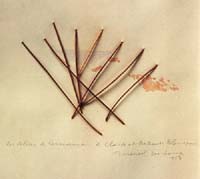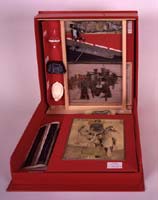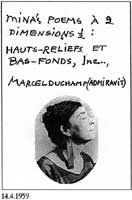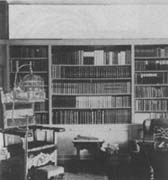| What may elude us is the fact that, in the painting, a fourth shadow is (almost) ever present, the true one (i.e. not painted) projected by a true bottlebrush planted in the center of the tear, perpendicularly to the canvas; and with this fourth, even the 3 shadows would be recursively brought again to 4 (= 22). I felt uneasy observing that the shadow of the Hat Rack seems awkwardly executed with respect to the other shadows whose execution is instead impeccable. Then I noticed that, while in the photos of the readymade the Hat Rack shows six stems, in the projected shadow one seems to see (although with some uncertainty) more than six stems: one, well marked, showing its typical curl, and others, blurred and only slightly suggested… Gi's interpretation is that we are observing the shadow of a shadow. This is the extraordinary (recursive) property of the generalized space enclosed by the prism.
A biographical event of Duchamp's seems to be in relation with what we observed, and it seems to indicate a persistent presence of the themes, here discussed, in Duchamp's thoughts that year. Reading Gough-Cooper and Caumont's Effemeridi, I learned that on July 23rd, 1918, Duchamp gave his friend Carrie Stettheimer, for her doll-house, a pencil-ink miniature (9.5x5.5 mm) of his Nude Descending a Staircase, No.2 (1912) (Fig. 18), that was collocated in the miniaturized dance room. So, we observe the same idea of repetition in a box that we encountered in Tu m', but here we have the further important specification of the reduced scale.
We can recognize traces of the same idea of repetition in boxes and on a reduced scale in other works too. Recall, for example, The Delights of Kermoune (1958) (Fig. 19): Duchamp created a tree-graph that recalls the Network of Stoppages, composed by pine needles fixed on a sheet of paper with the same tacking technique used for the Stoppages; it was a "thank you" present for the hospitality received in Kermoune by Claude and Bertrande Blanc pain. Duchamp put this work in a gray box hidden in the wardrobe of the hosts. In the idea of repetition in a box and on a reduced scale we may read a sort of foreboding of the fractal idea. A note in the Green Box states:
Thus, if Blancpain’s wardrobe had been such a mirror wardrobe (with inner mirrors), then the little gray box would have been infinitely repeated, just as in a fractal.
The theme of the repetition on a reduced scale is also widely developed in the Box in a Valise (1941) (Fig. 20). Here we notice another evocative resumption of the strange prism first observed in Tu m': let's look at the little model of the readymade Why Not Sneeze Rrose Sélavy? (1919), contained in the Box in a Valise (Fig. 21). The article Marcel Duchamp: A Readymade Case for Collecting Objects of Our Cultural Heritage Along with Works of Art underlines an important property of the work: the starting point is a photo (2D) of the famous readymade, the little bird cage is cut along the right, upper and left sides, and this outline is then folded upon a skewed, solid prism (3D) which has the section similar to the one of the prism of Tu m'. Thus, we have a 2D surface, which simulates a 3D object (by means of the fold along the upper side of the front of the cage, so that it can overlap to the correspondent side of the prism). So, the dimensionality of this new object is a number between the integers 2 and 3.
There is a surprising coincidence: the idea of repetition (of the shadow, in Tu m', and of the object on a reduced scale in the Box in a Valise) is openly associated with a non-integer dimensionality, i. e. with a fractal dimensionality: another evocative property of the strange prism. Elsewhere, we find Duchamp's direct mention of a non-integer dimension in the verses composed for Mina Loy--the title is Mina's Poems à 2 Dimensions ½ (Effemeridi, April, 14th, 1959) (Fig. 22). A clarification is now necessary, to avoid possible misinterpretations. I don't want to state either that the examined works (and others that we shall examine below) are fractals (fractals are well defined geometric objects, with several well defined properties which we can't observe in Duchamp’s work: this is absolutely obvious), or that Duchamp explicitly grasped such a concept. We must only acknowledge that the idea of recursive repetition on a reduced scale is objectively related to that of fractals, so that, in the presence of the idea of recursion (even though only suggested) the idea of the fractal must also take some evidence, at least in an embryonic form. I think (and I began to show elsewhere, Giunti, 2001b) that, to the extent that the intuition of recursion will become more and more definite and precise by artists, the representation of fractals will become conscious and more and more clear and pertinent (as in the cases of Klee and Escher). However, we must recognize that the intuition of a non-integer dimensionality, especially when related to the repetition on a lower scale, is an extraordinary intuition that we can't observe in any other artist of the same period, as far as I know. Remember also that Mandelbrot's first book on fractals, Les objets fractals gives the mathematical definition of fractals in terms of non-integer dimensionality and was issued in 1975. Finally, we return to Tu m' for a last consideration. A photo I have seen in the Effemeridi (January 9th, 1918) shows Miss Dreier's library room before the installation of Tu m' (Fig. 23). In the foreground we clearly see a birdcage. Maybe the strange prism was originally conceived just as a cage. >>Next Figs.
18-22
page 1 2 3 4 5 6 7 8 9 10 11 12 13 14 15 |



















